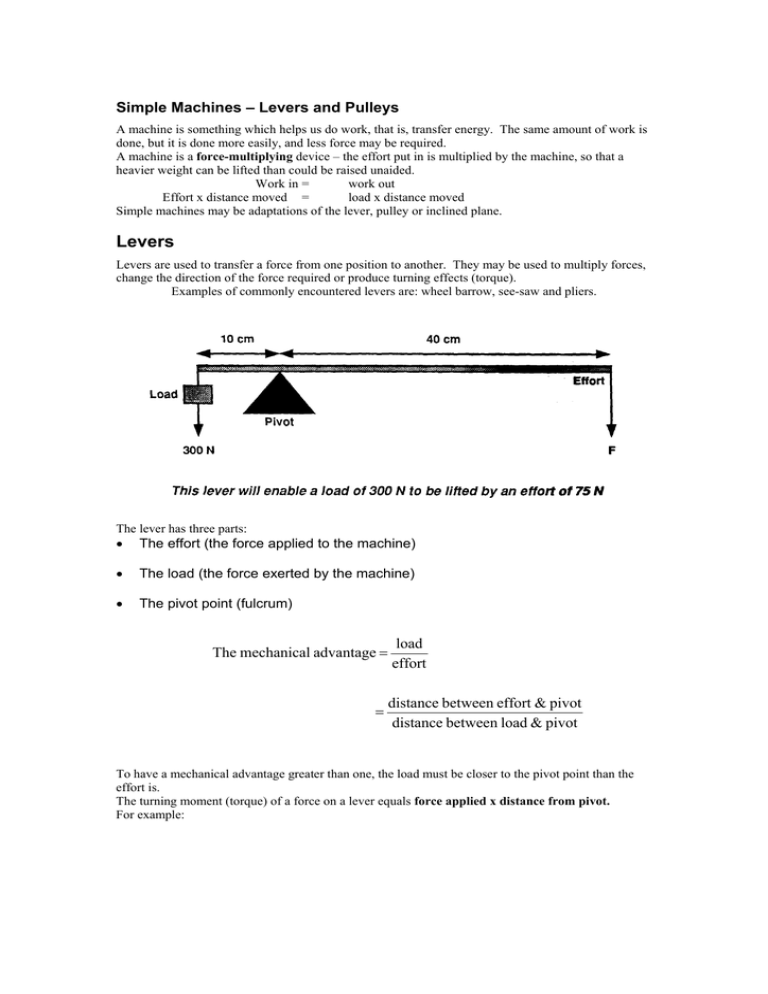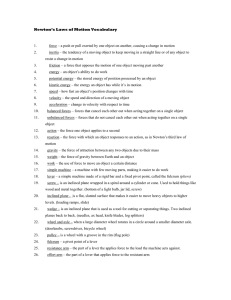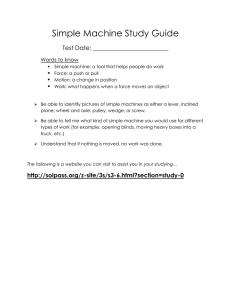Simple Machines – Levers and Pulleys
advertisement

Simple Machines – Levers and Pulleys A machine is something which helps us do work, that is, transfer energy. The same amount of work is done, but it is done more easily, and less force may be required. A machine is a force-multiplying device – the effort put in is multiplied by the machine, so that a heavier weight can be lifted than could be raised unaided. Work in = work out Effort x distance moved = load x distance moved Simple machines may be adaptations of the lever, pulley or inclined plane. Levers Levers are used to transfer a force from one position to another. They may be used to multiply forces, change the direction of the force required or produce turning effects (torque). Examples of commonly encountered levers are: wheel barrow, see-saw and pliers. The lever has three parts: • The effort (the force applied to the machine) • The load (the force exerted by the machine) • The pivot point (fulcrum) The mechanical advantage = = load effort distance between effort & pivot distance between load & pivot To have a mechanical advantage greater than one, the load must be closer to the pivot point than the effort is. The turning moment (torque) of a force on a lever equals force applied x distance from pivot. For example: The turning moment of the above lever is 20N x 2m = 40Nm (In a clockwise direction) For a balanced lever (in equilibrium), the sum of the clockwise moments must equal the sum of the anti-clockwise moments. For example: Clockwise moment = 6N x 1m = Anticlockwise moment = 2N x 3m = The above lever is in equilibrium. 6Nm 6Nm A Pulley system can also act as a force-multiplying device. An equal-armed lever and a single pulley are machines with a mechanical advantage of 1. The advantage of these is that they change the direction of the force required. Inclined Plane The same work is done in raising a load whether it goes straight up vertically or up an inclined plane. Up an inclined plane the effort is less, but the distance moved is greater, Examples, winding roads up steep hills; a screw thread is a spiral inclined plane. (The pitch of a screw is the distance moved vertically for one complete turn of the screw). Summary • The Centre of Gravity of an object is the point through which the weight of a body appears to act. • When the Centre of Gravity is directly above the base of an object, it is said to be in equilibrium, and will not topple. • A machine is something which helps work to be done, that is, it transfers energy. • Simple machines can be levers, pulleys, and inclined planes. • Simple machines may - change direction of force required produce a turning effect (torque) - multiply force applied, The mechanical advantage = = load effort distance between effort & pivot distance between load & pivot • For a balanced lever, the sum of anticlockwise moments = the sum of clockwise moments. • The turning moment of a lever = force x distance it is applied from the pivot.





